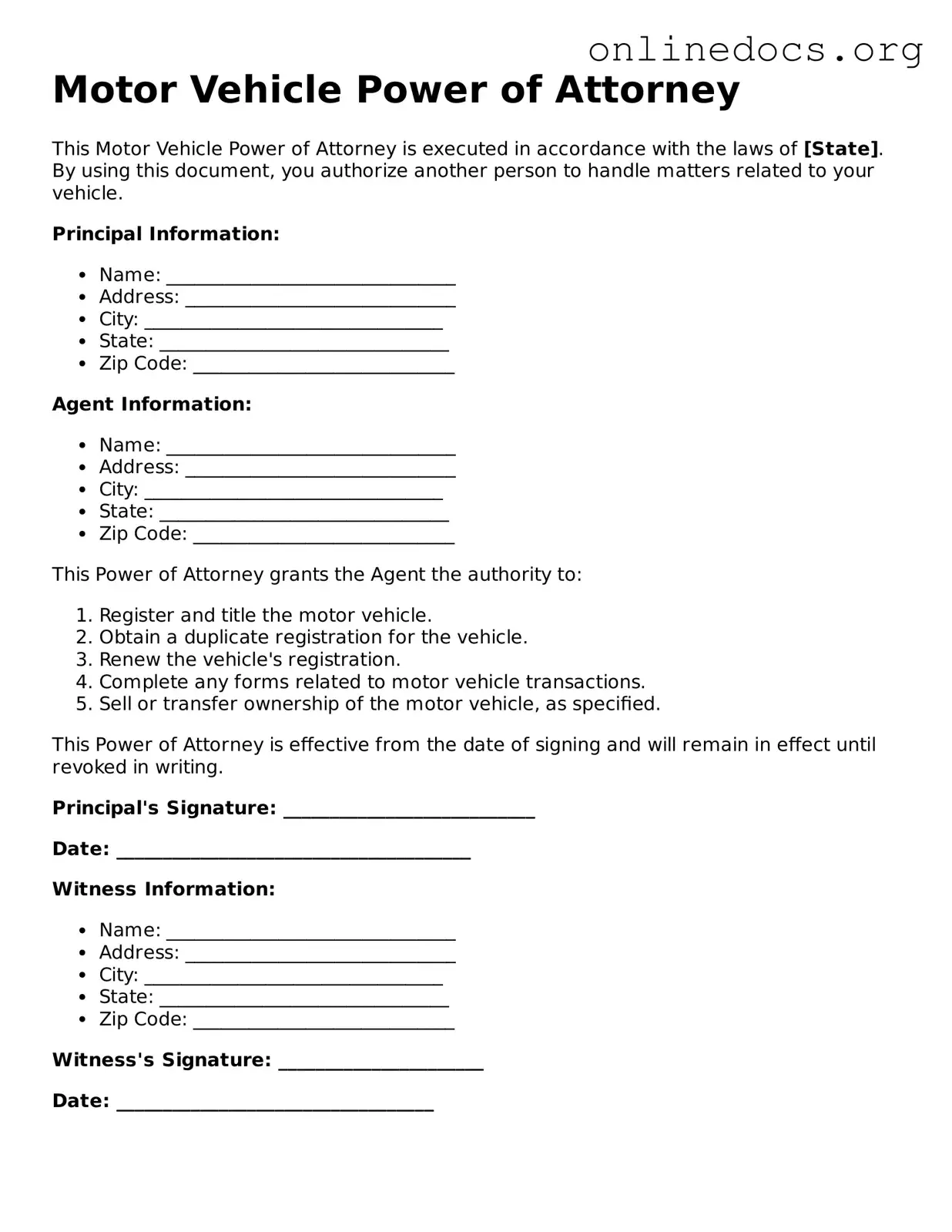The Motor Vehicle Power of Attorney form is similar to a General Power of Attorney. Both documents allow an individual to designate another person to act on their behalf. In the case of a General Power of Attorney, the authority granted can cover a wide range of financial and legal matters. However, the Motor Vehicle Power of Attorney is specifically tailored for transactions related to motor vehicles, such as registering a car or transferring ownership. This specificity makes it easier for individuals to manage vehicle-related affairs without granting broad powers over all aspects of their financial life.
Another document that shares similarities is the Limited Power of Attorney. Like the Motor Vehicle Power of Attorney, a Limited Power of Attorney restricts the authority granted to specific tasks or timeframes. While the Motor Vehicle version focuses solely on vehicle transactions, a Limited Power of Attorney can be used for various purposes, such as handling real estate transactions or managing bank accounts. This type of document is beneficial for individuals who want to maintain control over their affairs while delegating certain responsibilities to another person.
The Vehicle Title Transfer form also bears resemblance to the Motor Vehicle Power of Attorney. Both documents are essential when transferring ownership of a vehicle. The Vehicle Title Transfer form is used to officially change the title from one owner to another, while the Motor Vehicle Power of Attorney allows someone to act on behalf of the owner to complete this transfer. This collaboration ensures that the necessary paperwork is completed correctly and efficiently, simplifying the process for both parties involved.
A Bill of Sale is another document that serves a similar purpose. While the Motor Vehicle Power of Attorney allows someone to act on behalf of a vehicle owner, a Bill of Sale is the actual record of the sale transaction itself. It provides proof of the sale and details such as the purchase price, vehicle description, and the parties involved. When combined with a Power of Attorney, the Bill of Sale facilitates a smooth transaction, ensuring that all legal requirements are met during the sale of a vehicle.
If you're in California and looking to transfer ownership of a motorcycle, it's essential to complete the Motorcycle Bill of Sale form, an important legal document that clearly states the necessary details of the transaction. You can find this form easily by visiting fillpdf-forms.com/, ensuring a smooth and documented exchange of ownership.
The Authorization for Release of Information is also akin to the Motor Vehicle Power of Attorney. This document allows one party to request and receive specific information from another entity, such as a motor vehicle department or insurance company. In the context of vehicle transactions, it can be used to obtain details about a vehicle’s history or ownership. While the Motor Vehicle Power of Attorney grants authority to act on behalf of someone, the Authorization for Release of Information simply permits access to vital information, which can be crucial during vehicle transactions.
The Consent to Transfer form is another document that parallels the Motor Vehicle Power of Attorney. This form is often required by financial institutions or leasing companies when a vehicle is being transferred from one owner to another. It signifies that all parties involved consent to the transfer and outlines the terms of the agreement. While the Motor Vehicle Power of Attorney allows someone to execute the transfer on behalf of the owner, the Consent to Transfer form serves as a formal acknowledgment that the transfer is authorized and agreed upon by all parties.
Finally, the Vehicle Registration Application shares similarities with the Motor Vehicle Power of Attorney. Both documents are essential in the process of legally owning and operating a vehicle. The Vehicle Registration Application is used to register a vehicle with the state, while the Power of Attorney allows someone to complete this process on behalf of the vehicle owner. This ensures that the vehicle is properly registered without requiring the owner to be physically present, thereby streamlining the registration process.
